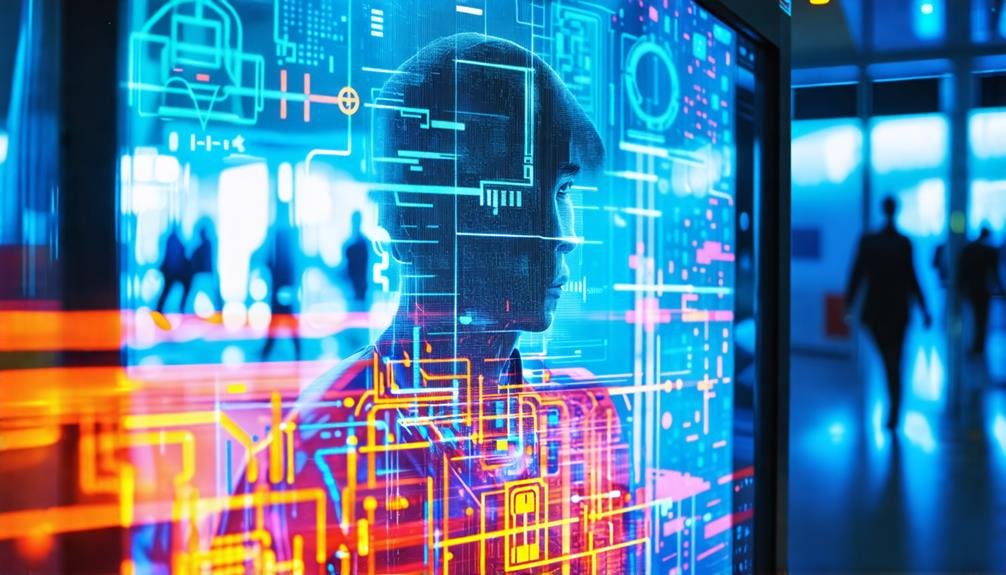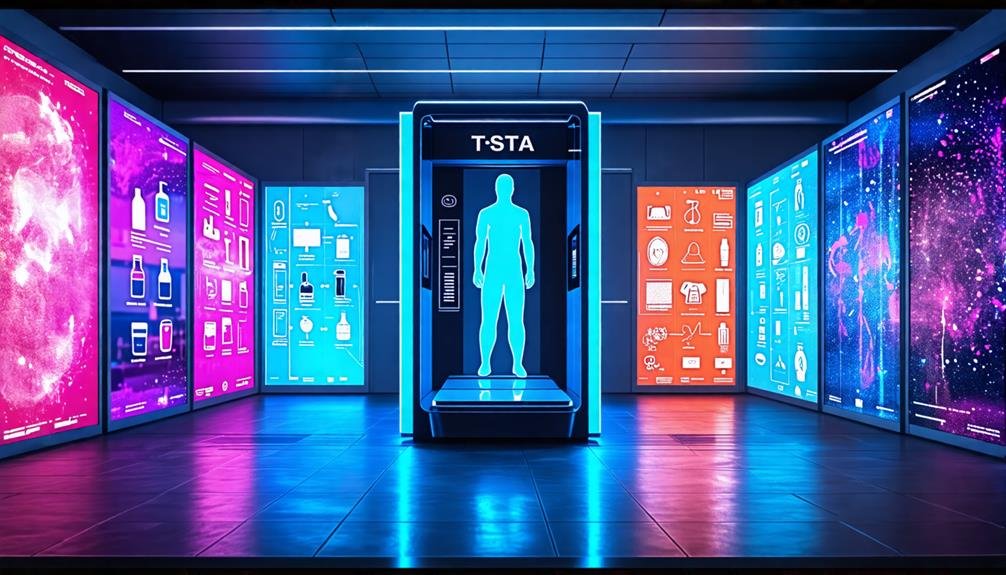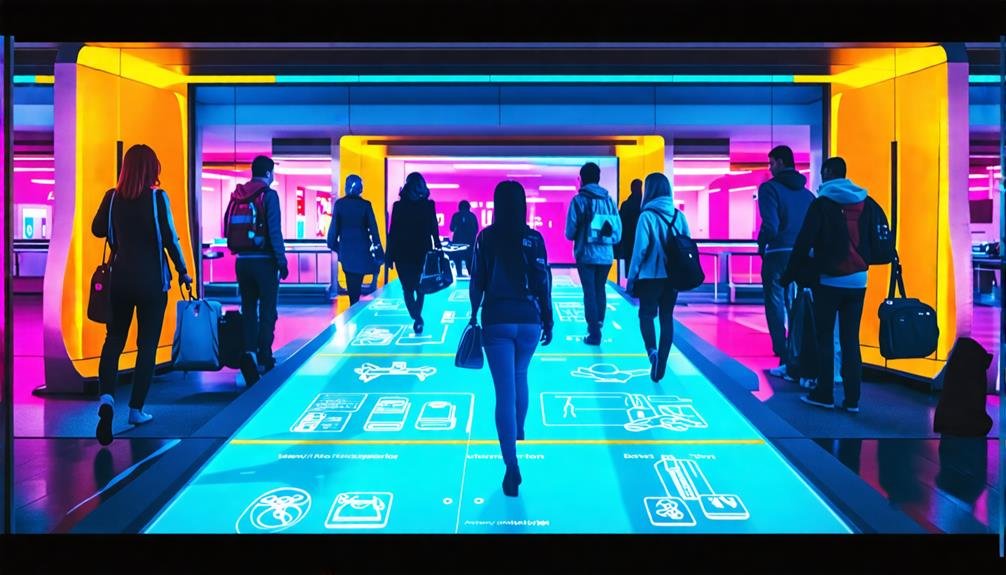TSA body scanners are designed to detect a variety of items, surprising many travelers by identifying personal hygiene products, such as menstrual cups and pads. This capability can create uncomfortable situations due to privacy concerns, as scanned images may lead to invasive searches or questioning. Moreover, while these scanners effectively identify some threats, they have significant limitations; for example, they only detect firearms about 30% of the time. The scanners also struggle to locate illegal drugs that are cleverly concealed. Understanding these detection capabilities reveals complexities in airport security that may prompt further investigation into the technology's future applications.
Unconventional Items Detected
TSA body scanners can detect a variety of unconventional items, including personal hygiene products like menstrual cups and pads. This detection raises concerns about privacy and the appropriateness of scanning such items. These TSA devices utilize advanced imaging technology to reveal objects hidden under clothing, leading to unexpected findings during security screenings.
While these scanners are effective at identifying potential threats, their capacity to detect everyday items can create uncomfortable scenarios for travelers. The scanning process of personal items sparks discussions regarding the balance between security measures and individual privacy rights. Many travelers worry about the implications of scanning sensitive items that do not compromise safety.
Despite their advanced capabilities, it is important to recognize the limitations of TSA scanners. They have received criticism for not detecting certain contraband, including narcotics, emphasizing the need for a more effective approach to travel security. As technology progresses, the ongoing dialogue about privacy and security will continue to influence the future of TSA screening practices.
Personal Hygiene Products
While security measures are crucial for traveler safety, the detection of feminine hygiene products by TSA body scanners raises important privacy issues for passengers. TSA scanners identify various items, including menstrual cups, pads, and specialized underwear. This functionality, while aimed at enhancing security, can unintentionally reveal personal and sensitive facets of an individual's life, causing discomfort and anxiety.
The consequences of such detection go beyond simple privacy concerns. Many passengers feel uneasy knowing their personal hygiene choices are examined in a public environment. Additionally, the risk of misinterpretation of scanned images can result in unwarranted questioning or invasive searches, undermining an individual's sense of autonomy and dignity.
As technology progresses, the equilibrium between security and personal privacy continues to be a critical topic. Travelers who cherish their freedom may struggle to navigate a system that seems to favor detection over discretion. In this context, ongoing discussions about the ethical ramifications of TSA body scanners are essential, as they influence the future of air travel and individual rights.
Limitations in Drug Detection

Airport body scanners struggle to identify illegal substances, often failing to detect drugs effectively. These advanced devices, while capable of spotting metallic and non-metallic threats, cannot reliably pinpoint drugs concealed in clothing or within the body. Many drugs lack the chemical signatures that scanners like the Rapiscan Secure 1000 are designed to detect, resulting in frequent oversights.
The various ways drugs can be hidden—such as liquids, powders, or integrated into organic materials—further complicate detection. This ineffectiveness raises alarms about air travel security, as individuals might take advantage of these vulnerabilities to smuggle substances that threaten public safety.
Although airport security strives to protect travelers, the limitations of body scanners in drug detection prompt scrutiny of their effectiveness within a comprehensive security framework. As the quest for personal freedom intensifies, the need to balance safety measures with civil liberties becomes more pressing. Upgrading technology and refining screening procedures are essential steps to enhance drug detection capabilities and address critical security gaps.
Weapons Detection Failures
Despite advancements in technology, TSA body scanners exhibit alarming failure rates in detecting weapons, reportedly missing them 70% of the time. Compounding this issue is the significant amount of defunct equipment stored, raising questions about the efficient use of taxpayer funds. Additionally, politicians have attributed these shortcomings to funding diversions, highlighting a troubling intersection of budgetary priorities and national security.
High Failure Rates
TSA body scanners exhibit a concerning failure rate, detecting firearms only 30% of the time. This alarming statistic raises critical questions about the effectiveness of security measures at airports. Despite significant investments in these advanced scanning technologies, they frequently miss concealed weapons, impacting passenger safety.
Reports show that these scanners struggle with identifying various types of firearms and explosives, highlighting a substantial gap in their operational capabilities. This failure is not just a technical flaw; it undermines trust in airport security systems. Travelers, who seek freedom in their journeys, may feel increasingly anxious knowing that a considerable percentage of potential threats could remain undetected.
Additionally, the high failure rates lead to wasted resources and funds allocated for what is meant to be a reliable security solution. As safety measures evolve, it is crucial for the TSA to address these deficiencies and explore innovative alternatives to enhance detection methods. The ultimate goal must be to ensure that passengers can travel freely while feeling confident in the effectiveness of the systems designed to protect them.
Equipment Storage Issues
Storing numerous outdated TSA body scanners highlights major inefficiencies in resource allocation for airport security. This predicament raises doubts about the scanners' effectiveness in detecting weapons, as many units remain unused despite considerable financial investments. The high failure rate in weapon detection has intensified scrutiny of these devices, which are intended to enhance public safety.
Key issues related to these storage challenges include:
- A concerning 70% failure rate in weapon detection.
- Financial resources tied up in outdated technology.
- Increased worries over budget allocation priorities.
The accumulation of non-operational scanners reflects a broader challenge within airport security. As the need for personal freedom and safety remains critical, the inefficiency of existing systems calls for a reassessment. The ongoing storage of ineffective body scanners not only squanders taxpayer funds but also undermines the goal of providing secure travel environments. Therefore, resolving these equipment storage challenges is essential for enhancing both operational efficiency and public trust in airport security measures.
Funding Diversion Blame
The inefficiencies revealed by the storage of outdated TSA body scanners highlight significant concerns regarding funding allocation, particularly in relation to the troubling 70% failure rate in detecting weapons. Despite substantial investments in advanced imaging systems like the Rapiscan Secure 1000, the returns on security have been disappointing, leading many to scrutinize the distribution of financial resources. Reports show that numerous scanners are non-operational, resulting in considerable waste of taxpayer dollars and raising serious questions about accountability within the Transportation Security Administration.
Critics point to funding misallocation as a critical factor contributing to this situation, where budget reductions and poor management have diminished the effectiveness of security protocols. With an emphasis on obsolete technologies and insufficient training for personnel, the TSA has faced challenges in providing travelers with the safety they expect. Moreover, the consequences of these failures go beyond statistics; they threaten to undermine public confidence in the agency responsible for ensuring aviation security.
As members of a society that values both freedom and safety, it is crucial to push for improved funding strategies that focus on acquiring and maintaining effective detection technologies. This approach would enhance overall airport security while respecting individual rights.
Privacy and Health Concerns

Privacy and health concerns surrounding TSA body scanners have sparked significant debate among passengers and advocacy groups. Critics argue that these devices not only invade personal privacy but also pose potential health risks due to radiation exposure, despite being generally considered safe for the majority of individuals. As technology evolves, it is essential to address these concerns while ensuring effective security measures are maintained at airports.
Privacy Invasion Issues
Concerns about privacy violations have sparked considerable discussion regarding the use of TSA body scanners, especially since these devices can potentially capture and transmit sensitive imagery of travelers. Such technologies have raised alarms about individual privacy and the ethical ramifications tied to surveillance in public areas.
Key issues include:
- Image Retention Issues: Early models of body scanners could store and transmit imagery, which led to apprehensions about potential misuse.
- Risk of Profiling: Body scanners have faced criticism for promoting racial profiling, which exacerbates social inequalities.
- Transparency Deficiency: Many travelers remain unaware of how their images are processed, leading to questions about informed consent.
As discussions about personal liberties gain momentum, the struggle between security measures and privacy rights continues to be a divisive topic. It is essential for governing bodies to confront these issues openly, ensuring that technology enhances public safety without infringing on individual rights. Moving forward necessitates a dedication to ethical standards that respect both security requirements and the fundamental freedoms of all passengers.
Health Risks From Radiation
Health implications linked to TSA's body scanners have sparked notable concerns, especially regarding potential radiation exposure during the screening procedure. The devices primarily use millimeter-wave technology, deemed safe, but discussions persist about cumulative exposure effects among health professionals.
Critics suggest that even low-level radiation exposure, experienced repeatedly by frequent flyers, could present health risks. Although adverse effects remain unproven, the long-term safety of these devices is questioned.
Individuals with specific medical conditions, such as those with pacemakers or expectant mothers, may be particularly cautious due to possible radiation implications. Clear communication from the TSA about these risks is crucial, ensuring travelers are informed about the technology involved in their screening process.
Passengers can choose to opt-out of the body scanner, allowing for alternative screening methods that may ease radiation exposure concerns. Striking a balance between security requirements and individual health considerations is essential for building public trust in airport security practices.
Passenger Rights and Opt-Outs
Travelers possess the right to decline full-body scans at TSA checkpoints, allowing them to select alternative screening methods if they feel uneasy with the procedure. This right empowers individuals to assert their personal freedoms while navigating security measures. When choosing to opt out, travelers typically experience a more comprehensive pat-down, which may take additional time but ensures they avoid a process that causes discomfort.
It is essential for travelers to understand their rights and available options. Key points include:
- Travelers must notify TSA personnel that they wish to opt out.
- Alternative screening options, such as pat-downs, are accessible.
- Opting out may result in extended wait times at checkpoints.
Being informed about these rights allows travelers to make educated choices regarding their journey. While safety is a priority, the ability to select an alternative screening method ensures that individuals retain a sense of autonomy, reinforcing the equilibrium between security and personal comfort.
Future Technological Advancements

As travelers assert their rights regarding screening methods, the future of Transportation Security Administration (TSA) body scanner technology is set for remarkable advancements that will enhance detection capabilities and improve passenger experiences. Innovations in detection algorithms are expected to boost the scanners' proficiency in identifying concealed items, addressing existing limitations. These enhancements may involve the incorporation of artificial intelligence from tech giants like IBM, enabling real-time threat evaluations through comprehensive data analysis.
Moreover, the implementation of biometric identification features from companies like Clear may streamline passenger processing, minimizing wait times while bolstering security. Future scanners are anticipated to utilize non-invasive techniques, providing detailed imaging without infringing on privacy. This tactic could alleviate concerns about the invasive nature of current screening methods and mitigate health risks tied to radiation exposure.
Partnerships with industry specialists, such as those at the American Association of Airport Executives, will be crucial for driving innovation and ensuring developments meet the requirements of both security agencies and travelers. Additionally, the integration of blockchain technology from firms like Microsoft may enhance data security, protecting personal information during the screening process. Altogether, these advancements will strive to create a more efficient, secure, and passenger-friendly airport experience while upholding individual rights and freedoms.
Impact on Airport Security
Improving airport security through advanced TSA body scanner technology is essential for identifying potential threats while maintaining passenger privacy and comfort. The use of body scanners has significantly impacted airport security, changing how security personnel detect concealed items and manage risks. However, it is vital to understand both the advantages and drawbacks of this technology.
Key impacts on airport security include:
- Enhanced Detection: Advanced scanners, such as those developed by L3 Technologies, are increasingly proficient at identifying a wider array of potential threats.
- Quicker Screening: Automated systems streamline passenger processing, reducing wait times and enhancing the travel experience.
- Varied Threat Identification: Body scanners can detect various items, including weapons and prohibited substances, although there are some limitations.
While TSA body scanners contribute to a more secure airport environment, ongoing assessments of their effectiveness and privacy implications remain crucial. By continuously refining these technologies, airports can better protect travelers while honoring their rights and preferences, ultimately achieving a balance between security and individual freedom.





































